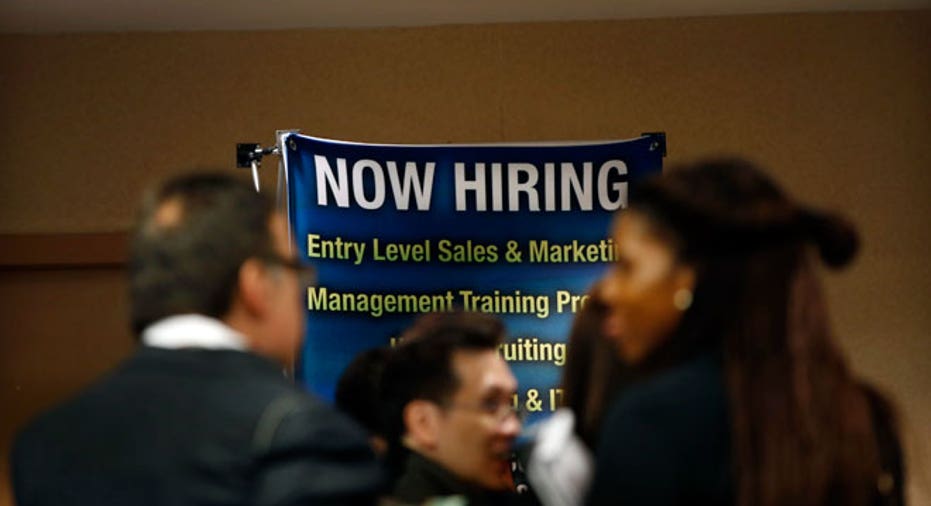U.S. Jobs Report Seen Strong, but Wages Tepid

U.S. job growth likely remained strong in March, underpinning economic growth, but tepid wage gains and weak global demand could keep the Federal Reserve cautious about raising interest rates this year.
Nonfarm payrolls probably increased 205,000 last month after rising 242,000 in February, according to a Reuters survey of economists. The unemployment rate is seen holding steady at an eight-year low of 4.9 percent in the U.S. Labor Department data due for publication on Friday.
The labor market has largely shrugged off slowing global economic growth, a robust U.S. dollar which has hurt manufacturing exports, and cheap oil which has hit energy sector profitability. Limited wage increases though have left the Fed wary about further rate hikes even as the labor market tightens.
"The March employment report will show that the U.S. economy is doing fine, but the Fed is very much focused on global developments right now and job growth takes a backseat," said Thomas Costerg, senior U.S. economist at Standard Chartered Bank in New York.
Fed Chair Janet Yellen said on Tuesday that slowing global growth and lower oil prices posed a downside risk to the domestic economic outlook, adding that she considered it appropriate for policymakers to "proceed cautiously in adjusting policy."
Fed officials last month downgraded their economic growth expectations and forecast only two more rate rises this year. The U.S. central bank raised its benchmark overnight interest rate in December for the first time in nearly a decade.
Financial markets have almost priced out the likelihood of a rate hike at the Fed's June policy meeting and see a roughly 47 percent chance of an increase in November and 57 percent probability at the December meeting, according to CME FedWatch.
The Labor Department's closely watched jobs report will be released on Friday at 8:30 a.m.(1230 GMT).
It will come on the heels of recent data showing sluggish consumer spending, weak business investment on capital in the first two months of the year, as well as some deterioration in the international trade balance, which prompted economists to slash their first-quarter GDP growth estimates to as low as a 0.9 percent annualized pace from as high as a 2.0 percent rate.
The economy grew at a 1.4 percent rate in the fourth quarter.
WAGES LIMITED
Though employment gains have slowed after averaging 282,000 jobs per month in the fourth quarter, there is little labor market strain from the global slowdown, which helped to ignite a massive stock market sell-off at the start of the year.
First-time applications for unemployment benefits are near the lowest levels seen in 1973. Economists attribute the pullback in job gains to the inability of companies to find qualified workers for vacant positions.
"Although first-quarter growth may not have been quite as strong as we initially believed, the resilience of the labor market suggests that the economy is not in any serious trouble," said Paul Ashworth, chief U.S. economist at Capital Economics in Toronto.
Wages likely increased last month, with average hourly earnings forecast rising 0.2 percent after slipping 0.1 percent in February. That would leave the year-on-year earnings gain at 2.2 percent, unchanged from February.
Economists say an economic growth rate of between 3.0 and 3.5 percent in wages is needed to lift inflation to the Federal Reserve's 2.0 percent target. Though the Fed's preferred inflation measure is currently at 1.7 percent, Yellen has expressed skepticism over the sustainability of gains citing transitory factors.
Little change is expected in other labor market measures. The labor force participation rate, or the share of working-age Americans who are employed or at least looking for a job, likely held at a more than one year-high of 62.9 percent.
"While labor market slack has reached low levels, we anticipate that further reductions will occur at a very gradual pace, which implies only a mild pickup in wage growth this year," said Peter D'Antonio, an economist at Citi in New York.
"We do not expect that such a mild pickup in wage growth would pose an inflationary threat to cause the Fed to alter its current, very dovish, policy stance."
Employment gains in March were likely broad-based, with manufacturing expected to have recouped some of the jobs lost in February amid signs of stabilization in the factory sector.
Mining likely purged more jobs last month. Mining payrolls have declined by 171,000 jobs since peaking in September 2014, with three-fourths of the losses in support activities.
Oilfield services providers Schlumberger <SLB.N> and Halliburton Co <HAL.N> have announced thousands of job cuts as they try to cope with reduced profits from a prolonged slump in oil prices.
Construction payrolls are expected to have increased for a ninth straight month. A fall in retail employment is expected after rising strongly in January and February despite weak sales. Government payrolls are expected to have increased by 8,000 last month.
(Reporting by Lucia Mutikani; editing by Dan Burns and Clive McKeef)



















